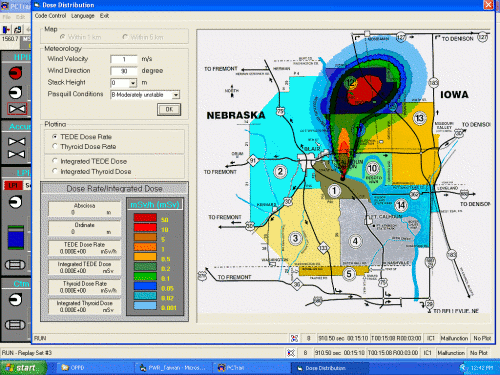PCTRAN is a reactor simulator specifically designed for nuclear plant emergency preparedness. Its scope includes severe accidents and intentional sabotage. Dose release following core melt, containment and/or spent fuel pool failure can be simulated. The sixth generation has integrated all aspects of accident scenario from inside to outside of a plant. PCTRAN keeps track of radioactive isotopes from inside the core fuel elements, its leakage to the reactor coolant, subsequent spill into the containment and secondary buildings, and to eventual offsite dose dispersion. Current meteorological conditions are used for puff and plume projection in the plant's emergency planning zone. The integrated dose level can then be used for activation level determination and/or protective action decision.
PCTRAN is designed for the Microsoft Windows environment. Operation is user-friendly in its graphical-user-interface (GUI). In each of the nuclear steam supply system (NSSS), containment and emergency planning zone (EPZ) mimics, there are data panels and buttons for operator control and animation for a "live" demonstration. For instance, control rods and water levels move up or down according to operator's maneuvering, and containment air space flashes with a bang when hydrogen burn takes place. Dose projection allows wind speed, direction and stability class changes. A typical PC's processor can achieve all these at a speed many times faster than real-time.
PCTRAN is the only tool that integrates inside-plant simulation with outside-plant dose projection. It replaces separate training simulators and cumbersome procedures with a single computerized tool. A well-tested and plant specific system could even assist consequence prediction and dose projection during a real event. Over a quarter century after the TMI event and intensive planning for emergency, the industry should not feel "good enough" in its technology. Investment in advanced tools further assures overall safety.

Biography - Li-Chi Cliff Po
Dr. Li-chi Cliff Po is the president of Micro-Simulation Technology. The company was founded in 1985 as a software development and consulting service for the nuclear industry.
Since 1996, Dr. Po has been a lecture director for International Atomic Energy Agency's annual "Advanced Reactor Simulation" workshop. In 2006 his company completed projects at plants Calvert Cliffs, Ginna, and Turkey Point in the US and Tsuruga in Japan. State of Pennsylvania acquired models of Beaver Valley and Limerick. An emergency exercise system was also installed at the Japanese national Nuclear Emergency Assistance and Training Center (NEAT). In the past he has provided consultation to government agencies such as USNRC, Swiss HSK, Japanese NUPEC and JAERI, German TUEV, Finnish TVO, and authorities of Taiwan, Indonesia and Egypt. The company's copyrighted simulation software PCTRAN, has been installed in over one hundred locations in the world.
Dr. Po graduated from National Taiwan University with a BS in physics and from University of Manchester in U.K. with a PhD in theoretical physics. He has previously worked for Ebasco Services, Con Edison of New York and GPU Nuclear. He has published over 30 technical papers in "Nuclear Science and Engineering", "Nuclear Technology", "Nuclear Engineering International", etc.
|



